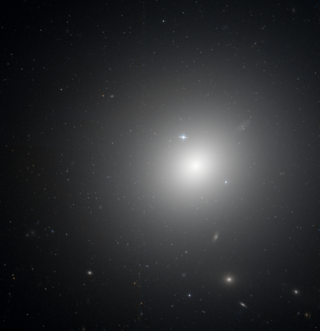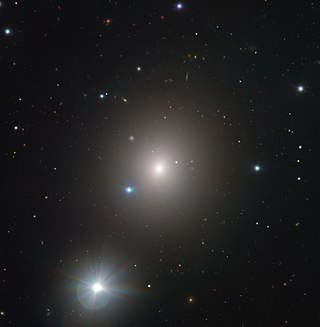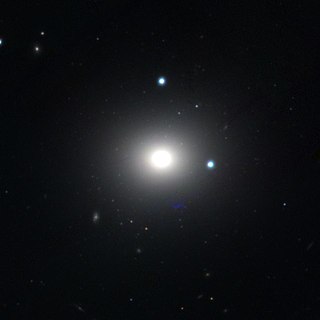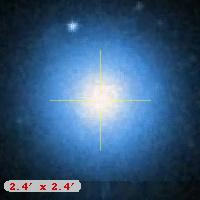
Fornax is a constellation in the southern celestial hemisphere, partly ringed by the celestial river Eridanus. Its name is Latin for furnace. It was named by French astronomer Nicolas Louis de Lacaille in 1756. Fornax is one of the 88 modern constellations.

Star clusters are large groups of stars held together by self-gravitation. Two main types of star clusters can be distinguished. Globular clusters are tight groups of ten thousand to millions of old stars which are gravitationally bound. Open clusters are more loosely clustered groups of stars, generally containing fewer than a few hundred members, that are often very young. As they move through the galaxy, over time, open clusters become disrupted by the gravitational influence of giant molecular clouds. Even though they are no longer gravitationally bound, they will continue to move in broadly the same direction through space and are then known as stellar associations, sometimes referred to as moving groups.

An elliptical galaxy is a type of galaxy with an approximately ellipsoidal shape and a smooth, nearly featureless image. They are one of the three main classes of galaxy described by Edwin Hubble in his Hubble sequence and 1936 work The Realm of the Nebulae, along with spiral and lenticular galaxies. Elliptical (E) galaxies are, together with lenticular galaxies (S0) with their large-scale disks, and ES galaxies with their intermediate scale disks, a subset of the "early-type" galaxy population.

A lenticular galaxy is a type of galaxy intermediate between an elliptical and a spiral galaxy in galaxy morphological classification schemes. It contains a large-scale disc but does not have large-scale spiral arms. Lenticular galaxies are disc galaxies that have used up or lost most of their interstellar matter and therefore have very little ongoing star formation. They may, however, retain significant dust in their disks. As a result, they consist mainly of aging stars. Despite the morphological differences, lenticular and elliptical galaxies share common properties like spectral features and scaling relations. Both can be considered early-type galaxies that are passively evolving, at least in the local part of the Universe. Connecting the E galaxies with the S0 galaxies are the ES galaxies with intermediate-scale discs.

NGC 1316 is a lenticular galaxy about 60 million light-years away in the constellation Fornax. It is a radio galaxy and at 1400 MHz is the fourth-brightest radio source in the sky.

NGC 1427 is a low-luminosity elliptical galaxy located approximately 71 million light-years away from Earth. It was discovered by John Frederick William Herschel on November 28, 1837. It is a member of the Fornax Cluster. The galaxy has a stellar mass of 7.9 × 1010M☉, and a total mass of 9.4 × 1010M☉. However, the mass of the dark matter halo surrounding the galaxy is around 4.3 × 1012M☉.

NGC 1427A, also known as ESO 358-49, or ESO 358- G 049, is an irregular galaxy in the constellation Fornax. Its distance modulus has been estimated using the globular cluster luminosity function to be 31.01 ± 0.21 which is about 52 Mly. It is the brightest dwarf irregular member of the Fornax cluster and is in the foreground of the cluster's central galaxy NGC 1399.

NGC 1399 is a large elliptical galaxy in the Southern constellation Fornax, the central galaxy in the Fornax Cluster. The galaxy is 66 million light-years away from Earth. With a diameter of 130 000 light-years, it is one of the largest galaxies in the Fornax Cluster and slightly larger than the Milky Way. William Herschel discovered this galaxy on October 22, 1835.

NGC 1404 is an elliptical galaxy in the Southern constellation Eridanus. It was discovered on November 28, 1837, by the astronomer John Herschel. Based on the tip of the red-giant branch distance indicator, it lies at a distance of approximately 60 million light-years from the Milky Way. It is one of the brightest members of the Fornax Cluster.

NGC 3610 is an elliptical galaxy in the constellation Ursa Major. It was discovered on 8 April 1793 by German-British astronomer William Herschel. This galaxy is located at a distance of 106 million light-years (32.5 Mpc) from the Milky Way, and is receding with a galacto-centric radial velocity of 1,819 km/s.

NGC 1395 is an elliptical galaxy located in the constellation Eridanus. It is located at a distance of circa 75 million light years from Earth, which, given its apparent dimensions, means that NGC 1395 is about 130,000 light years across. It was discovered by William Herschel on November 17, 1784. It is a member of the Eridanus Cluster.

NGC 1380 is a lenticular galaxy located in the constellation Fornax. It is located at a distance of circa 60 million light years from Earth, which, given its apparent dimensions, means that NGC 1380 is about 85,000 light years across. It was discovered by James Dunlop on September 2, 1826. It is a member of the Fornax Cluster.

NGC 1381 is a lenticular galaxy located in the constellation Fornax. It is located at a distance of about 60 million light years from Earth, which, given its apparent dimensions, means that NGC 1381 is about 55,000 light years across. It is a member of the Fornax Cluster. NGC 1381 appears edge-on and features a thin disk with high surface brightness and a boxy bulge. Both the box-shaped bulge and the kinematics of the central area of the galaxy suggest that NGC 1381 has a bar.

NGC 4278 is an elliptical galaxy located in the constellation Coma Berenices. It is located at a distance of circa 55 million light years from Earth, which, given its apparent dimensions, means that NGC 4278 is about 65,000 light years across. It was discovered by William Herschel on March 13, 1785. NGC 4278 is part of the Herschel 400 Catalogue and can be found about one and 3/4 of a degree northwest of Gamma Comae Berenices even with a small telescope.

NGC 1387 is a lenticular galaxy in the constellation Fornax, in the Fornax Cluster. It was discovered by William Herschel on December 25, 1835.

NGC 1375 is a barred lenticular galaxy in the constellation Fornax discovered by John Herschel on November 29, 1837. It is believed to be a member of the Fornax Cluster.

NGC 4318 is a small lenticular galaxy located about 72 million light-years away in the constellation Virgo. It was discovered by astronomer John Herschel on January 18, 1828. NGC 4318 is a member of the Virgo W′ group, a group of galaxies in the background of the Virgo Cluster that is centered on the giant elliptical galaxy NGC 4365.

NGC 1379 is a low-luminosity elliptical galaxy in the southern constellation Fornax. It was discovered by William Herschel on December 25, 1835.

NGC 1428 is a peculiar galaxy of an uncertain morphology; either an elliptical or lenticular galaxy located approximately 65 million light-years away from Earth.

NGC 1373 is a dwarf elliptical galaxy located 61 million light years away in constellation of Fornax. The galaxy was discovered by astronomer John Herschel on November 29, 1837, and is a member of the Fornax Cluster. NGC 1373 is a host to a supermassive black hole with an estimated mass of 4.6 million solar masses.




















